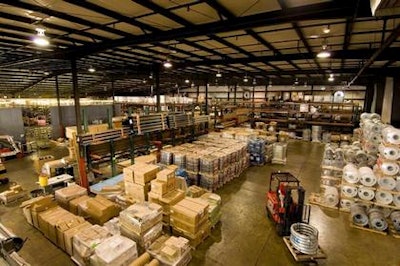
Wholesale sales edged up 0.2 percent to $53.1 billion in August. Gains in three subsectors, in particular the machinery, equipment and supplies subsector, more than offset declines elsewhere. Excluding the motor vehicle and parts subsector, which recorded the largest decline, wholesale sales rose 1.0 percent.
In volume terms, wholesale sales edged up 0.1 percent.
The machinery, equipment and supplies subsector recorded the largest gain in August, rising 3.6 percent to a record high $11.3 billion, on the strength of gains in all industries. The largest contributor was the computer and communications equipment and supplies industry (+5.7 percent), which rose for the fourth time in five months. Following declines in the two previous months, sales rose in both the construction, forestry, mining, and industrial machinery, equipment and supplies industry (+2.7 percent) as well as the farm, lawn and garden machinery and equipment industry (+5.1 percent).
Sales in the miscellaneous subsector rose 1.2 percent to $6.7 billion. The other miscellaneous industry (+7.4 percent), which includes wholesalers of logs, wood chips, minerals, ores and precious metals, reached its highest level since October 2011, more than offsetting a second consecutive decline in the agricultural supplies industry (-6.3 percent), which fell to its lowest level in nine months.
The motor vehicle and parts subsector declined 3.7 percent to $9.2 billion, offsetting most of the 4.5 percent increase recorded in July. Year to date unadjusted sales for this subsector are 5.4 percent higher compared with the same period last year. All industries contributed to the decrease in August, led by the motor vehicle industry (-4.2 percent). Exports, imports, and manufacturing sales of motor vehicles also declined in August.
Sales increased in four provinces in August, which together represented 67 percent of total wholesale sales in Canada. Ontario accounted for much of the gain.
Sales in Ontario increased for a fifth consecutive month, rising 0.5 percent to $26.0 billion in August, despite a decline in the motor vehicle and parts subsector. One of the main contributors to the increase in August was the machinery, equipment and supplies subsector.
In Newfoundland and Labrador, sales increased 10.6 percent to $422 million. Sales in this province tend to be more volatile than in other provinces.
Sales rose 1.1 percent to $2.0 billion in Saskatchewan, following a 6.3 percent decline in July. The machinery, equipment and supplies subsector was a large contributor to the gain.
Following three consecutive monthly gains, sales decreased 0.5 percent to $9.6 billion in Quebec. The personal and household goods subsector led the decline.
Sales in British Columbia fell 0.6 percent to $5.1 billion, a third consecutive decline. The food, beverage and tobacco subsector was the largest contributor to the decrease.
For the second time in three months, sales decreased in New Brunswick (-1.7 percent), Nova Scotia (-0.9 percent) and Prince Edward Island (-4.2 percent). Lower sales in the food, beverage and tobacco subsector led the declines in all three provinces.
Inventories increased for an eighth consecutive month in August, edging up 0.2 percent to $66.8 billion, the highest level on record. Five of the seven subsectors, which represent 69 percent of wholesale inventories, recorded gains.
In dollar terms, the largest gain was in the machinery, equipment and supplies subsector (+0.8 percent), a seventh increase in eight months. Inventories grew for a seventh consecutive month in the miscellaneous subsector (+1.1 percent), while inventories in the food, beverage and tobacco subsector (+0.4 percent) rose for a sixth consecutive month.
Inventories declined in the motor vehicle and parts subsector (-1.3 percent), following two consecutive monthly gains.
The inventory-to-sales ratio remained at 1.26 in August. The inventory-to-sales ratio is a measure of the time in months required to exhaust inventories if sales were to remain at their current level.






















